A Three-Dimensional Coupled Hydrodynamic-Ecological Modeling to Assess the Planktonic Biomass in a Subalpine Lake
Abstract
:1. Introduction
2. Materials and Methods
2.1. Description of the Study Site and Data
2.2. Hydrodynamic Model
2.3. Phytoplankton and Zooplankton Modules
2.4. Model Setups
2.5. Statistical Error for Model Performance
2.6. Metric for Sensitivity Analysis
3. Model Validation
3.1. Water Depth
3.2. Water Temperature
3.3. Water Quality and Ecology
4. Results and Discussion
4.1. Sensitivity Analysis of Phytoplankton and Zooplankton Biomass
4.2. Effect of Water Temperature and Inflow on Phytoplankton and Zooplankton Biomass
4.3. Limitations
5. Conclusions
Supplementary Materials
Author Contributions
Funding
Institutional Review Board Statement
Informed Consent Statement
Data Availability Statement
Acknowledgments
Conflicts of Interest
References
- Dodds, W.K.; Perkin, J.S.; Ferken, J.E. Human impact on freshwater ecosystem services: A global perspective. Environ. Sci. Technol. 2013, 47, 9061–9068. [Google Scholar] [CrossRef] [PubMed]
- Kimura, N.; Liu, W.C.; Tsai, J.W.; Chiu, C.Y.; Kratz, T.K.; Tai, A. Contribution of extreme meteorological forcing to vertical mixing in a small, shallow subtropical lake. J. Limnol. 2017, 76, 116–128. [Google Scholar] [CrossRef] [Green Version]
- Zhang, T.; Ban, X.; Wang, X.; Cai, X.; Li, E.; Wang, Z.; Yang, C.; Zhang, Q.; Lu, X. Analysis of nutrient transport and ecological response in Hinghu Lake, China by using a mathematical model. Sci. Total Environ. 2017, 575, 418–428. [Google Scholar] [CrossRef] [PubMed]
- Janssen, A.B.G.; Janse, J.H.; Beusen, A.H.W.; Chang, M.; Harrison, J.A.; Huttunen, L.; Kong, X.; Rost, J.; Teurlincx, S.; Troost, T.A.; et al. How to model algal blooms in any lake on earth. Curr. Opin. Environ. Sustain. 2019, 36, 1–10. [Google Scholar] [CrossRef]
- Soulignac, F.; Anneville, O.; Bouffard, D.; Chanudet, V.; Dambrine, E.; Guenand, Y.; Harmel, T.; Ibelings, B.W.; Trevisan, D.; Uittenbogaard, R.; et al. Contribution of 3D coupled hydrodynamic-ecological modeling to assess the representativeness of a sampling protocol to lake water quality assessment. Knowl. Manag. Aquat. Ecosyst. 2019, 420, 42. [Google Scholar] [CrossRef]
- Chen, W.; Nielsen, A.; Andersen, T.K.; Hu, F.; Chou, Q.; Sondergaard, M.; Jeppesen, E.; Trolle, D. Modeling the ecological response of a temporarily summer-stratified lake to extreme heatwaves. Water 2020, 12, 94. [Google Scholar] [CrossRef] [Green Version]
- Holguin-Gonzalez, J.E.; Everaert, G.; Boets, P.; Galvis, A.; Goethals, P.L.M. Development and application of an integrated ecological modelling framework to analyze the impact of wastewater discharges on the ecological water quality of rivers. Environ. Model. Softw. 2013, 48, 27–36. [Google Scholar] [CrossRef]
- Bucak, T.; Trolle, D.; Tavsanohlu, U.N.; Cakiroglu, A.I.; Ozen, A.; Jeppesen, E.; Beklioglu, M. Modeling the effect of climatic and land use change on phytoplankton and water quality of the largest Turkish freshwater lake: Lake Beysehi. Sci. Total Environ. 2018, 621, 802–816. [Google Scholar] [CrossRef] [PubMed]
- Khwairakpam, E.; Khosa, R.; Gosain, A.; Nema, A. Monitoring and mode1ling water quality of Loktak Lake catchment. SN Appl. Sci. 2019, 1, 491. [Google Scholar] [CrossRef] [Green Version]
- Hipsey, M.R.; Hamilton, D.P.; Hanson, P.C.; Carey, C.C.; Coletti, J.Z.; Read, J.S.; Ibelings, B.W.; Valesini, F.J.; Brookes, J.D. Predicting the resilience and recovery of aquatic systems: A framework for model evolution within environmental observatories. Water Resour. Res. 2015, 51, 7023–7043. [Google Scholar] [CrossRef] [Green Version]
- Bocaniov, S.A.; Leon, L.F.; Rao, Y.R.; Schwab, D.J.; Scavia, D. Simulating the effect of nutrients on hypoxia in a large lake (Lake Erie, USA-Canada) with a three-dimensional lake model. J. Great Lakes Res. 2016, 42, 1228–1240. [Google Scholar] [CrossRef]
- Chen, Y.; Song, L.; Liu, Y.; Yang, L.; Li, D. A review of the artificial neural network models for water quality prediction. Appl. Sci. 2020, 10, 5776. [Google Scholar] [CrossRef]
- Crossman, J.; Bussi, G.; Whitehead, P.G.; Butterfield, D.; Lannergard, E.; Futter, M.N. A new, catchment-scale integragted water quality model of phosphorus, dissolved oxygen, biochemical oxygen demand and phytoplankton: INCA-phosphorus ecology (PEco). Water 2021, 13, 723. [Google Scholar] [CrossRef]
- Amorim, L.F.; Martins, J.R.S.; Nogueira, F.F.; Silva, F.P.; Duarte, B.P.S.; Magalhaes, A.A.B.; Vincon-Leite, B. Hydrodynamic and ecological 3D modeling in tropical lakes. SN Appl. Sci. 2021, 3, 444. [Google Scholar] [CrossRef]
- Sharip, Z.; Yanagawa, R.; Terasawa, T. Eco-hydrodynamic modelling of Chini Lake: Model description. Environ. Model. Assess. 2016, 21, 193–210. [Google Scholar] [CrossRef]
- Gao, H.; Shi, Q.; Qian, X. A multi-species modelling approach to select appropriate submerged macrophyte species for ecological restoration in Gonghu Bay, Lake Taihu, China. Ecol. Model. 2017, 369, 179–188. [Google Scholar] [CrossRef]
- Johnston, J.M.; Barber, M.C.; Wolfe, K.; Galvin, M.; Cyterski, M.; Parmar, R. An integral ecological modeling system for assessing impacts of multiple stressors on stream and riverine ecosystem services within river basins. Ecol. Model. 2017, 354, 104–114. [Google Scholar] [CrossRef] [PubMed]
- Wang, Z.; Chai, F.; Dugdale, R.; Liu, Q.; Xue, H.; Wilkerson, F.; Chao, Y.; Zhang, Y.; Zhang, H. The interannual variabilities of chlorophyll and nutrients in San Francisco Bay: A modeling study. Ocean Dynam. 2020, 70, 1169–1186. [Google Scholar] [CrossRef]
- Shalby, A.; Elshemy, M.; Zeidan, B.A. Assessment of climate change on water quality parameters of Lake Burullus, Egypt. Environ. Sci. Pollut. Res. 2020, 27, 32157–32178. [Google Scholar] [CrossRef]
- Vigouroux, G.; Chen, Y.; Jonsson, A.; Cvetkovic, V.; Destouni, G. Simulaiton of nureient management and hydroclimic effects on coastal water quality and ecological status-The Baltic Himmerfjarden Bay case. Ocean Coast. Manag. 2020, 198, 105360. [Google Scholar] [CrossRef]
- Khangaonkar, T.; Nugraha, A.; Premathilake, L.; Keister, J.; Borde, A. Projections of algae, eelgrass, and zooplankton ecological interactions in the inner Salish Sea-for future climate, and altered oceanic states. Ecol. Model. 2021, 441, 109420. [Google Scholar] [CrossRef]
- Man, X.; Lei, C.; Carey, C.C.; Little, J.C. Relative performance of 1-D versus 3-D hydrodynamic, water-quality models for predicting water temperature and oxygen in a shallow, eutrophic, managed reservoir. Water 2021, 13, 88. [Google Scholar] [CrossRef]
- Zhao, Y.W.; Xu, M.J.; Xu, F.; Wu, S.R.; Yin, X.A. Development of a zoning-based environmental ecological coupled model for lakes: A case study of Baiyangdian Lake in northern China. Hydrol. Earth Syst. Sci. 2014, 18, 2113–2126. [Google Scholar] [CrossRef] [Green Version]
- Verhamme, E.M.; Redder, T.M.; Schlea, D.A.; Grush, J.; Bratton, J.F.; DePinto, J.V. Development of the Western Lake Eric Ecosystem Model (WLEEM): Applicaiton to connect phosphorus loads to cyanobacteria biomass. J. Great Lakes Res. 2016, 42, 1193–1205. [Google Scholar] [CrossRef] [Green Version]
- Luo, L.; Wang, J.; Hunter, T.; Wang, D.; Vanderploeg, H.A. Modeling spring-summer phytoplankton bloom in Lake Michigan with and without riverine nutrient loading. Ocean Dynam. 2017, 67, 1481–1494. [Google Scholar] [CrossRef]
- Makler-Pick, V.; Hipsey, M.R.; Zohary, T.; Carmel, Y.; Cal, G. Intraguild predication dynamics in a lake ecosystem based on a coupled hydrodynamic-ecological model: The example of Lake Kinneret (Israel). Biology 2017, 6, 22. [Google Scholar] [CrossRef] [PubMed]
- Snortheim, C.A.; Hanson, P.C.; McMahon, K.D.; Read, J.S.; Carey, C.C.; Dugan, H.A. Meteorological drivers of hypolimnetic anoxia in eutrophic, north temperate lake. Ecol. Model. 2017, 343, 39–53. [Google Scholar] [CrossRef] [Green Version]
- Couture, R.M.; Moe, S.J.; Lin, Y.; Kaste, O.; Haande, S.; Solheim, A.L. Simulating water quality and ecological status of Lake Vansjo, Norway, under land-use and climate change by linking process-oriented models with a Bayesian network. Sci. Total Environ. 2018, 621, 713–724. [Google Scholar] [CrossRef]
- Luo, L.; Hamilton, D.P.; Lan, J.; McBride, C.; Trolle, D. Autocalibration of one-dimensional hydrodynamic-ecological model (DYRESM 4.0-CAEDYM 3.1) using a Monte Carlo approaches: Simulation of hypoxic events in a polymictic lake. Geosci. Model Dev. 2018, 11, 903–913. [Google Scholar] [CrossRef] [Green Version]
- Fenocchi, A.; Rogora, M.; Morabito, G.; Marchetto, A.; Sibilla, S.; Dresti, C. Applicability of a one-dimensional coupled ecological-hydrodynamic numerical model to future projections in a very deep large lake (Lake Maggiore, Northern Italy/Southern Switzerland). Ecol. Model. 2019, 392, 38–51. [Google Scholar] [CrossRef]
- Bocaniov, S.A.; Lamb, K.G.; Liu, W.; Rao, Y.R.; Smith, R.E.H. High sensitivity of lake hypoxia to air temperature, winds, and nutrient loading: Insights from a 3-D lake model. Water Resour. Res. 2020, 56, e2019WR027040. [Google Scholar] [CrossRef]
- Chiu, C.Y.; Jones, J.R.; Rusak, J.A.; Lin, H.C.; Nakayama, K.; Kratz, T.K.; Liu, W.C.; Tang, S.L.; Tsai, J.W. Terrestrial loads of dissolved organic matter drive inter-annual carbon flux in subtropical lakes during times of drought. Sci. Total Environ. 2020, 717, 137052. [Google Scholar] [CrossRef] [PubMed]
- Liu, W.C.; Liu, H.M.; Chiu, C.Y. Investigating suspended-sediment transport in a shallow lake using a three-dimensional hydrodynamic and sediment model. J. Earth Syst. Sci. 2019, 128, 29. [Google Scholar] [CrossRef] [Green Version]
- Zhang, Y.J.; Ateljevich, E.; Yu, H.C.; Wu, C.H.; Tu, J.C.S. A new vertical coordinate system for a 3D unstructured-grid model. Ocean Model. 2015, 85, 16–31. [Google Scholar] [CrossRef]
- Zhang, Y.J.; Ye, F.; Stanev, E.V.; Grashorn, S. Seamless cross-scale modeling with SCHISM. Ocean Model. 2016, 102, 64–81. [Google Scholar] [CrossRef] [Green Version]
- Zhang, Y.; Baptista, A.M. SELFE: A semi-implicit Eulerian-Lagrangian finite-element model for cross-scale ocean circulation. Ocean Model. 2008, 21, 71–96. [Google Scholar] [CrossRef]
- Umlauf, L.; Burchard, H. A generic length-scale equation for geophysical turbulence model. J. Mar. Res. 2003, 61, 235–265. [Google Scholar] [CrossRef]
- Kantha, L.H.; Clayson, C.A. An improved mixed layer model for geophysical applications. J. Geophys. Res. 1994, 99, 25235–25266. [Google Scholar] [CrossRef]
- Ye, F.; Zhang, Y.J.; Wang, H.V.; Friedrichs, M.A.M.; Irby, I.D.; Alteljevich, E.; Valle-Levinson, A.; Wang, Z.; Huang, H.; Shen, J.; et al. A 3D unstructured-grid model for Chesapeake Bay: Importance of bathymetry. Ocean Model. 2018, 127, 16–39. [Google Scholar] [CrossRef] [Green Version]
- Chao, Y.; Farrara, J.D.; Zhang, H.; Zhang, Y.J.; Ateljevich, E.; Chai, F.; Davis, C.O.; Dugdale, R.; Wilkerson, F. Development, implementation, and validation of a modeling system for the San Francisco Bay and Estuary. Estuar. Coast. Shelf Sci. 2017, 194, 40–56. [Google Scholar] [CrossRef]
- Du, J.; Shen, J.; Zhang, Y.L.; Ye, F.; Liu, Z.; Wang, Z.; Wang, Y.P.; Yu, X.; Sisson, M.; Wang, H.V. Tidal response to sea-level-rsie in different types of estuaries: The importance of length, bathymetry, and geometry. Geophys. Res. Lett. 2017, 45, 227–235. [Google Scholar] [CrossRef] [Green Version]
- Stanev, E.V.; Grashorn, S.; Zhang, Y.J. Cascading ocean basins: Numerical simulations of the circulation and interbasin exchange in the Azov-Black-Marmara-Mediterranean Seas system. Ocean Dynam. 2017, 67, 1003–1025. [Google Scholar] [CrossRef]
- Liu, Q.; Anderson, E.J.; Zhang, Y.; Weinke, A.D.; Knapp, K.L.; Biddanda, B.A. Modeling reveals the role of coastal upwelling and hydrological inputs on biologically distinct water exchanges in a Great Lakes estuary. Estuar. Coast. Shelf Sci. 2018, 209, 41–55. [Google Scholar] [CrossRef]
- Liu, Q.; Chai, F.; Dugdale, R.; Chao, Y.; Xue, H.; Rao, S.; Wilkerson, F.; Farrara, J.; Zhang, H.; Wang, Z.; et al. San Francisco Bay nutrients and plankton dynamics as simulated by a coupled hydrodynamic-ecosystem model. Cont. Shelf Res. 2018, 161, 29–48. [Google Scholar] [CrossRef]
- Du, J.; Park, K.; Shen, J.; Zhang, Y.J.; Yu, X.; Ye, F.; Wang, Z.; Rabalais, N.N. A hysrosynamic model for Galveston Bay and the shelf in the northern Gulf of Mexico. Ocean Sci. 2019, 15, 951–966. [Google Scholar] [CrossRef] [Green Version]
- Fortunato, A.B.; Meredith, E.P.; Rodrigue, M.; Freire, P.; Feldmann, H. Near-furture changes in storm surges along the Atlantic Iberian coast. Nat. Hazards 2019, 98, 1003–1020. [Google Scholar] [CrossRef]
- Ye, F.; Zhang, Y.J.; Yu, H.; Sun, W.; Moghimi, S.; Myers, E.; Nunez, K.; Zhang, R.; Wang, H.V.; Roland, A.; et al. Simulating storm surge and compound flooding events with a creek-to-ocean model: Importance of baroclinic effects. Ocean Model. 2020, 145, 101526. [Google Scholar] [CrossRef]
- Cai, X.; Zhang, Y.L.; Shen, J.; Wang, H.; Wang, Z.; Qin, Q.; Ye, F. A numerical study of hypoxia in Cheaspeake Bay using an unstructured grid model: Validaiton and sensitivty to bathymetry represetnation. J. Am. Water Resour. Assoc. 2021, in press. [Google Scholar]
- Willmott, C.J. On the validation of models. Phys. Geogr. 1981, 2, 184–194. [Google Scholar] [CrossRef]
- Li, M.; Zhong, L.; Boicourt, W.C. Simulations of Chesapeake Bay estuary: Sensitivity to turbulence mixing parameterizations and comparison with observations. J. Geophys. Res. Oceans 2005, 110, 1–22. [Google Scholar] [CrossRef]
- Megrey, B.A.; Rose, K.A.; Klumb, R.A.; Hay, D.E.; Werner, F.E.; Eslinger, D.L.; Smith, S.L. A bioenergetics-based population dynamics model of Pacific herring (Clupea harengus pallasi) coupled to a lower tropic level nutrient-phytoplankton-zooplankton model: Description, calibration, and sensitivity analysis. Ecol. Model. 2007, 202, 144–164. [Google Scholar] [CrossRef] [Green Version]
- Gal, G.; Hipsey, M.R.; Parparov, A.; Wagner, U.; Makler, V.; Zohary, T. Implementation of ecological modeling as effective management and investigation tool: Lake Kinneret as a case study. Ecol. Model. 2009, 220, 1697–1718. [Google Scholar] [CrossRef]
- Huang, J.; Gao, J.; Hormann, G.; Fohrer, N. Modeling the effects of environmental variables on short-term spatial changes in phytoplankton biomass in a large shallow lake, Lake Taihu. Environ. Earth Sci. 2014, 72, 3609–3621. [Google Scholar] [CrossRef]
- Li, Y.; Liu, Y.; Zhao, L.; Hastings, A.; Guo, H. Exploring change of internal nutrients cycling in a shallow ale: A dynamic nutrient driven phytoplankton model. Ecol. Model. 2015, 313, 137–148. [Google Scholar] [CrossRef]
- Bowie, G.L.; Mills, W.B.; Porcella, D.B.; Campbell, C.L.; Pagenkopf, J.R.; Rupp, G.L.; Johnson, K.M.; Chan, P.W.H.; Cherini, S.A.; Chamberlin, C.E. Rates, Constants and Kinetics Formulations in Surface Water Quality Modeling, 2nd ed.; EPA/600/0-85/040; Environmental Research Laboratory, US EAP: Washington, DC, USA, 1985; 455p. [Google Scholar]
- Park, K.; Kuo, A.Y.; Shen, J.; Hamrick, J.M. A Three-Dimensional Hydrodynamic-Eutrophication Model (HEM-3D): Description of Water Quality and Sediment Process Submodels; Special Report in Applied Marine Science and Ocean Engineering No.37; School of Marine Sciences, Virginia Institute of Marine Sciences, College of William and Mary: Williamsburg, VA, USA, 1995. [Google Scholar]
- Hirst, A.G.; Bunker, A.J. Growth of marine planktonic copepods: Global rates and pattern in relation to chlorophyll a, temperature, and body weight. Limnol. Oceanogr. 2003, 48, 1988–2010. [Google Scholar] [CrossRef] [Green Version]
- DiToro, D.; Fitzpatrick, J.; Thomann, R. Water Quality Analysis Simulation Program (WASP); US EAP: Washington, DC, USA, 2008. [Google Scholar]
- Wang, C.F.; Hsu, M.H.; Liu, W.C.; Hwang, J.S.; Wu, J.T.; Kuo, A.Y. Simulation of water quality and plankton dynamics in the Danshuei River estuary, Taiwan. J. Environ. Sci. Health A 2007, 42, 933–953. [Google Scholar] [CrossRef]
- Tetra Tech, Inc. The Environmental Fluid Dynamics Code Theory and Computation Volume 3: Water Quality Module; Tetra Tech, Inc.: Fairfax, VA, USA, 2007; 90p. [Google Scholar]
- Kerimoglu, O.; Jacquet, S.; Vinvon-Leite, B.; Lemaire, B.J.; Rimet, F.; Soulignac, F.; Trevisan, D.; Anneville, O. Modelling the plankton groups of the deep, peri-alpine Lake Bourget. Ecol. Model. 2017, 359, 415–433. [Google Scholar] [CrossRef] [Green Version]
- Hipsey, M.R.; Bruce, L.C.; Boon, C.; Busch, B.; Carey, C.C.; Hamilton, D.P.; Hanson, P.C.; Read, J.S.; de Sousa, E.; Weber, M.; et al. A General Lake Model (GLM 3.0) for linking high-frequency sensor data from the Global Lake Ecological Observatory Network (GLEON). Geosci. Model Develop. 2019, 12, 473–523. [Google Scholar] [CrossRef] [Green Version]
- Gebre, S.; Biossy, T.; Alfredsen, K. Sensitivity to climate change of the thermal structure and ice cover regime of three hydropower reservoirs. J. Hydrol. 2014, 510, 208–277. [Google Scholar] [CrossRef] [Green Version]
- Dou, M.; Ma, X.; Zhang, Y.; Zhang, Y.Y.; Shi, Y. Modeling the interaction of light and nutrients as factors driving lake eutrophication. Ecol. Model. 2019, 400, 41–52. [Google Scholar] [CrossRef]
- Fenocchi, A.; Rogora, M.; Morabito, G.; Marchetto, A.; Sibilla, S.; Dresti, C. Model simulation of the ecological dynamics induced by climate cna nutreient load changes for deep subalpine Lake Maggiore (Italy/Switzerland). J. Limnol. 2020, 79, 221–237. [Google Scholar] [CrossRef]
- Leon, L.F.; Smith, R.E.H.; Hipsey, M.R.; Bocaniov, S.A.; Higgins, S.N.; Hecky, R.E.; Antenucci, J.P.; Imberger, J.A.; Guildford, S.J. Application of a 3D hydrodynamic-biological model for seasonal and spatial dynamics of water quality and phytoplankton in Lake Erie. J. Great Lakes Res. 2011, 37, 41–53. [Google Scholar] [CrossRef]
- Park, Y.; Cho, K.H.; Kang, J.H.; Lee, S.W.; Kim, J.H. Developing a flow control strategy to reduce nutrient load in a reclaimed multi-reservoir system using a 2D hydrodynamic and water quality model. Sci. Total. Environ. 2014, 466–467, 871–880. [Google Scholar] [CrossRef] [PubMed]
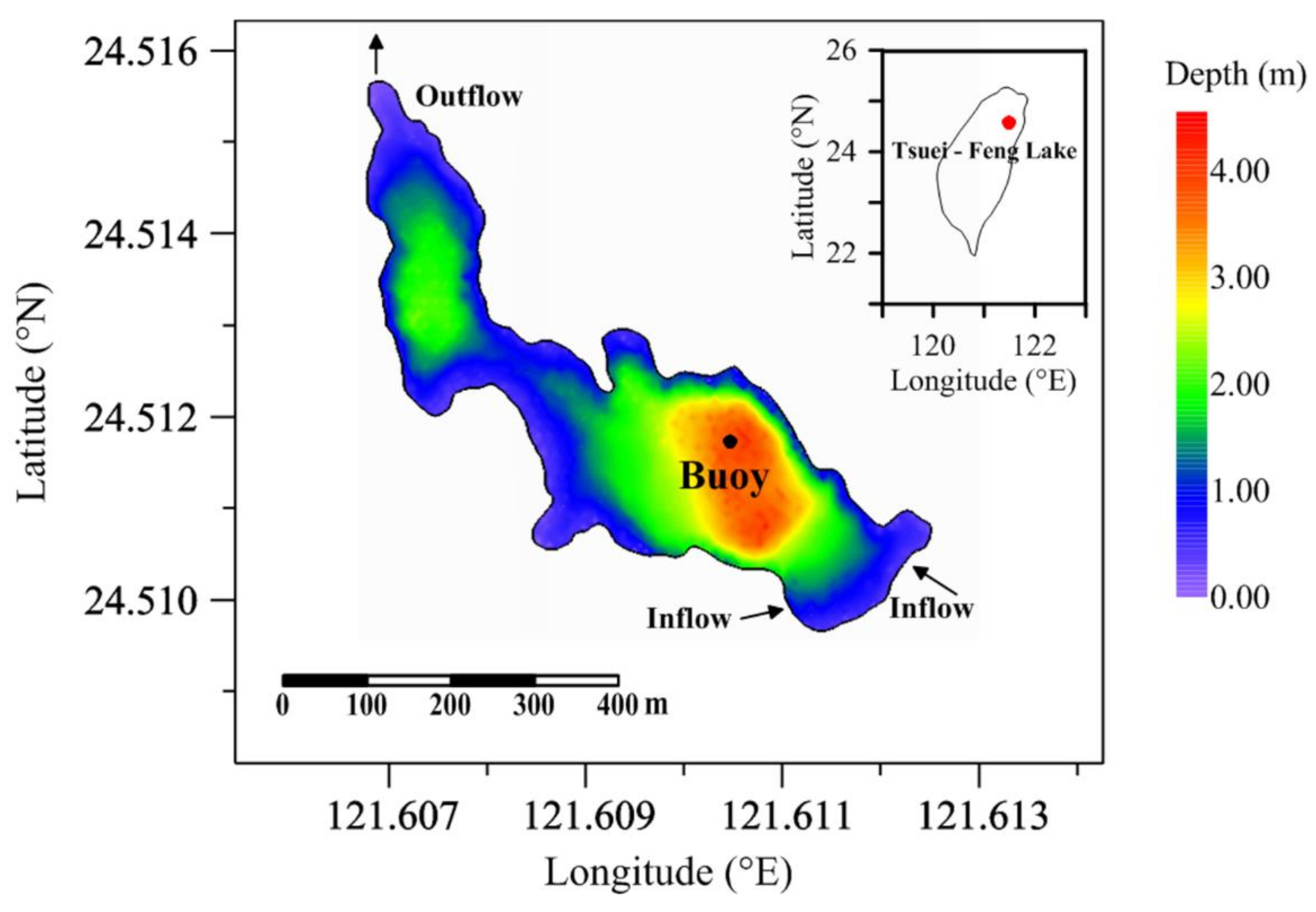
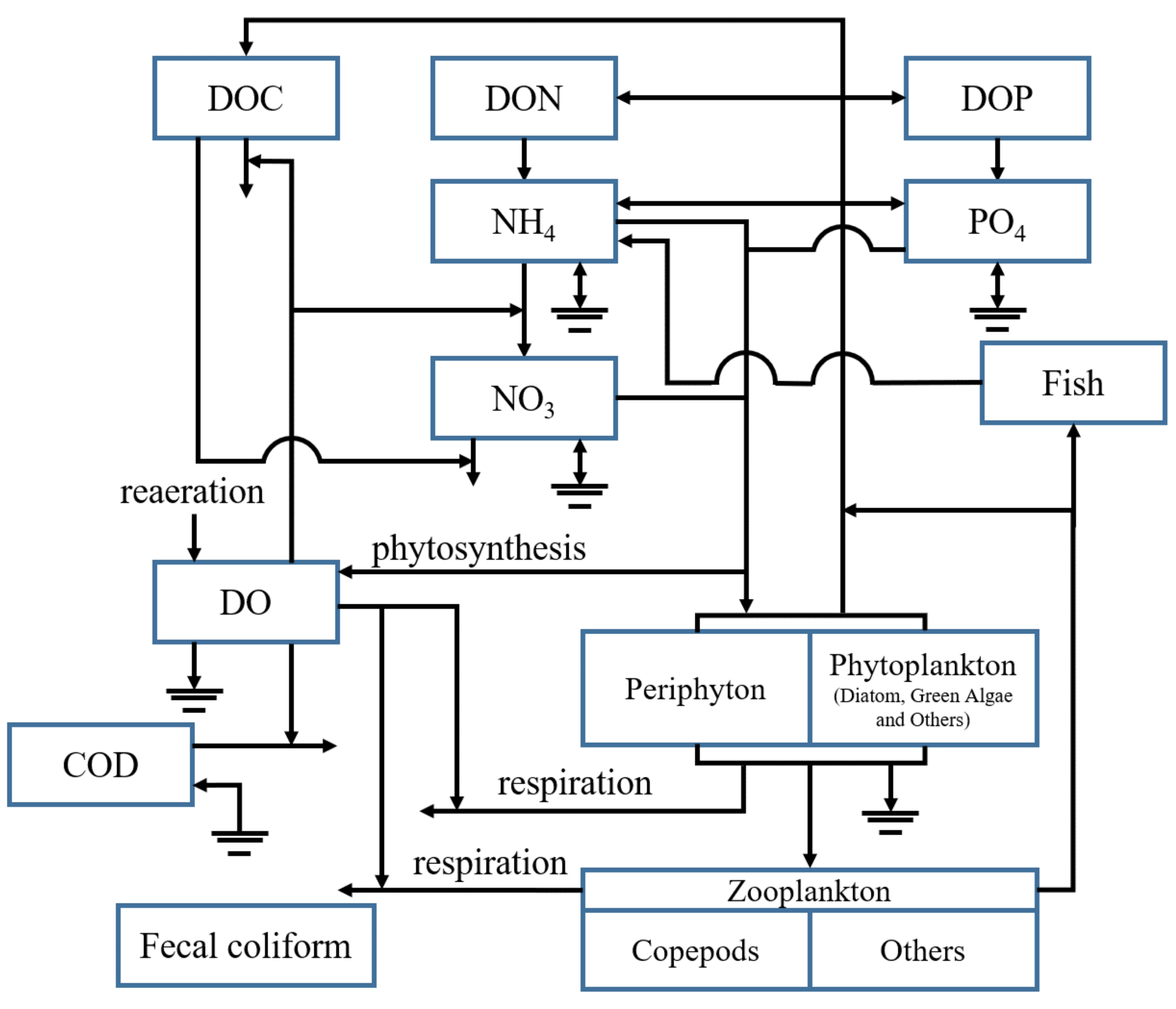
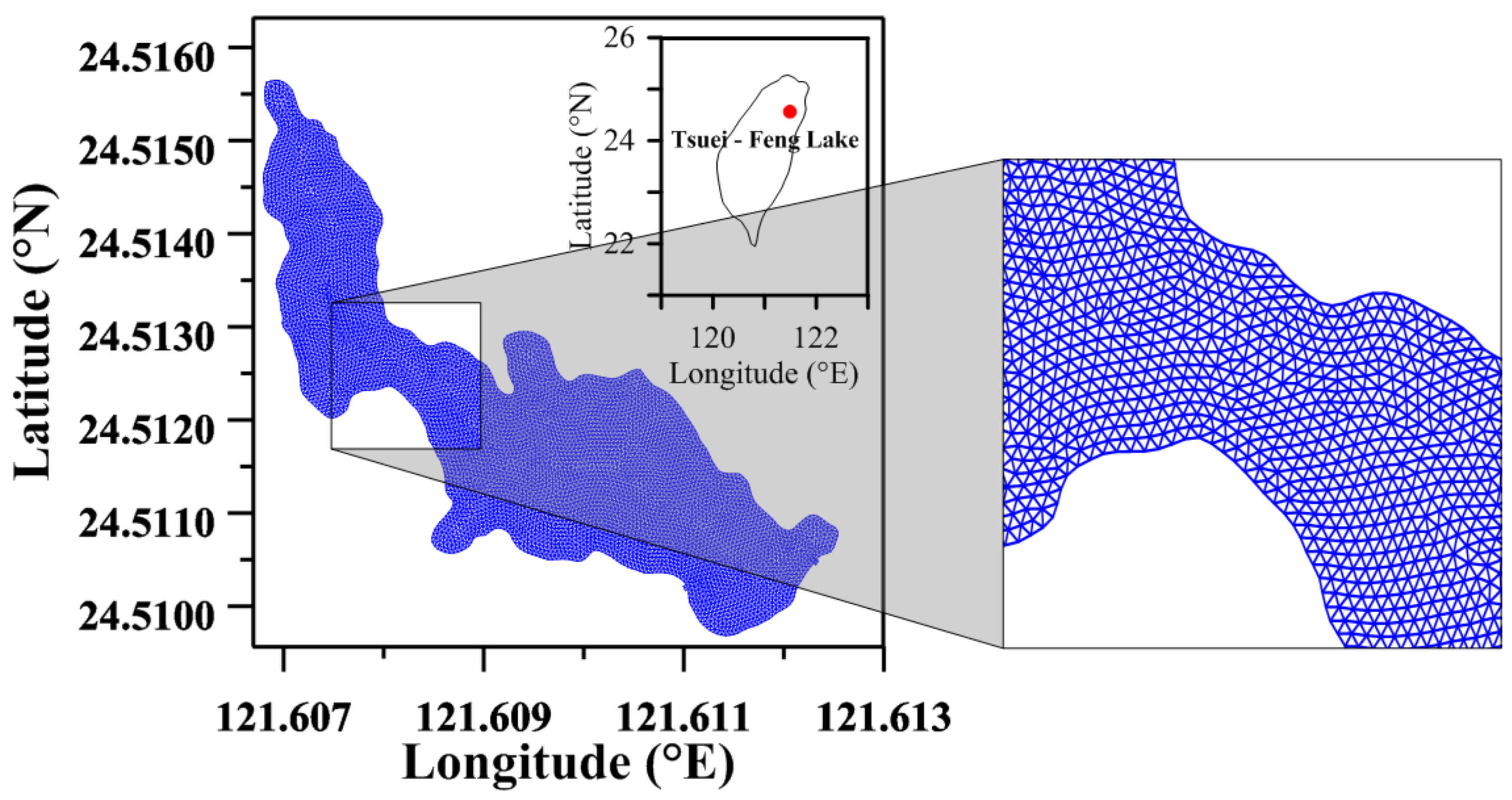
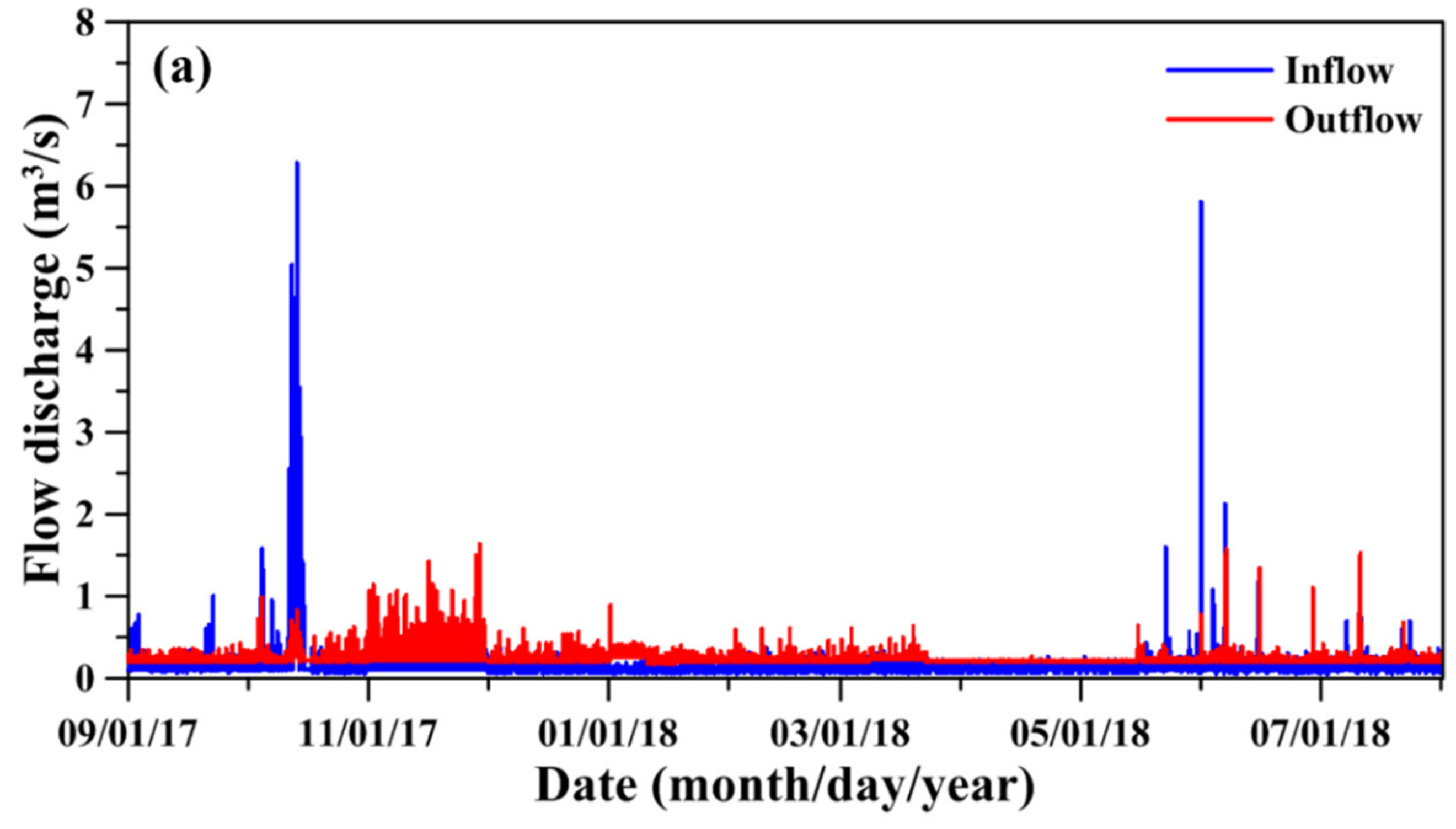

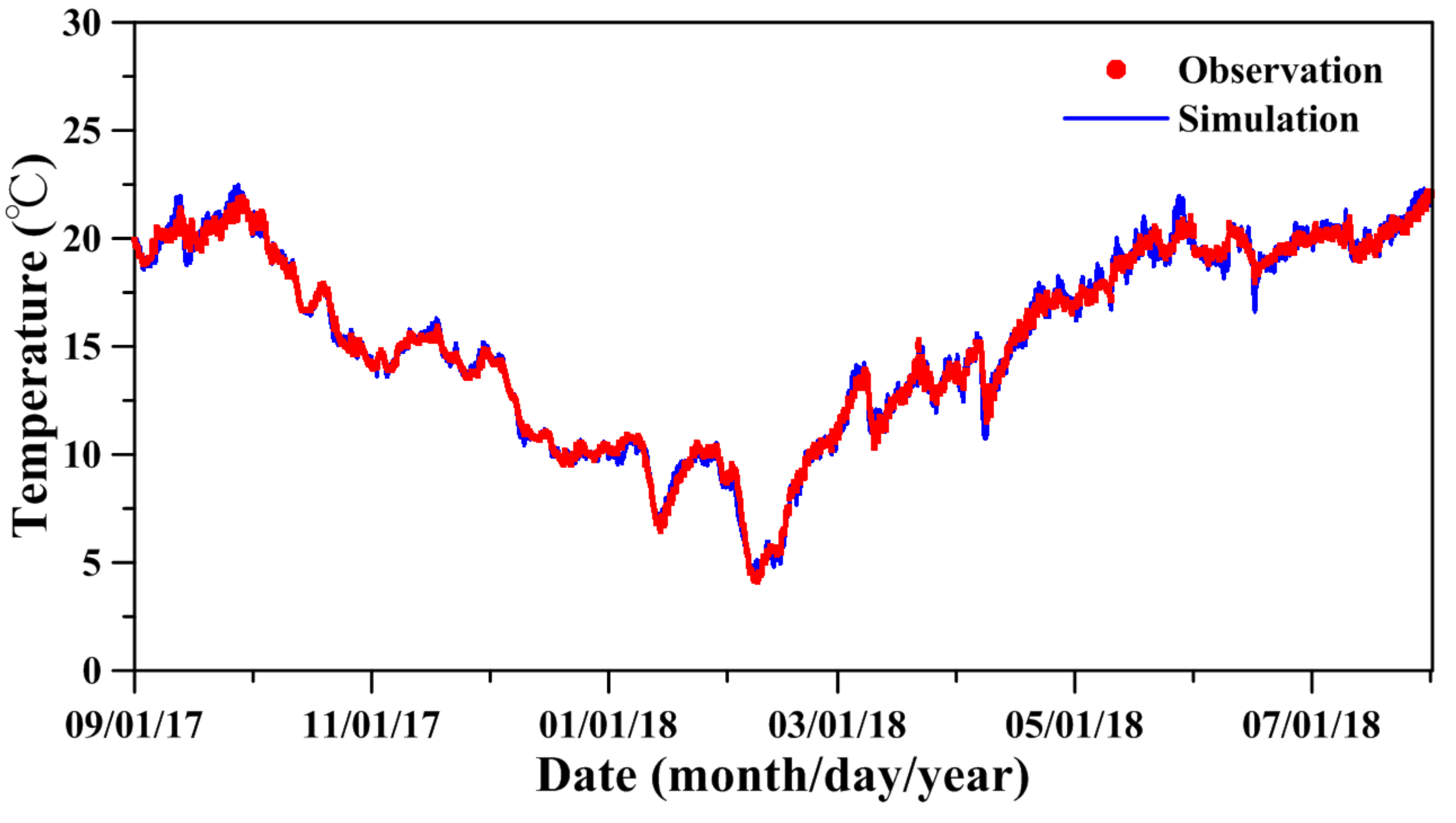


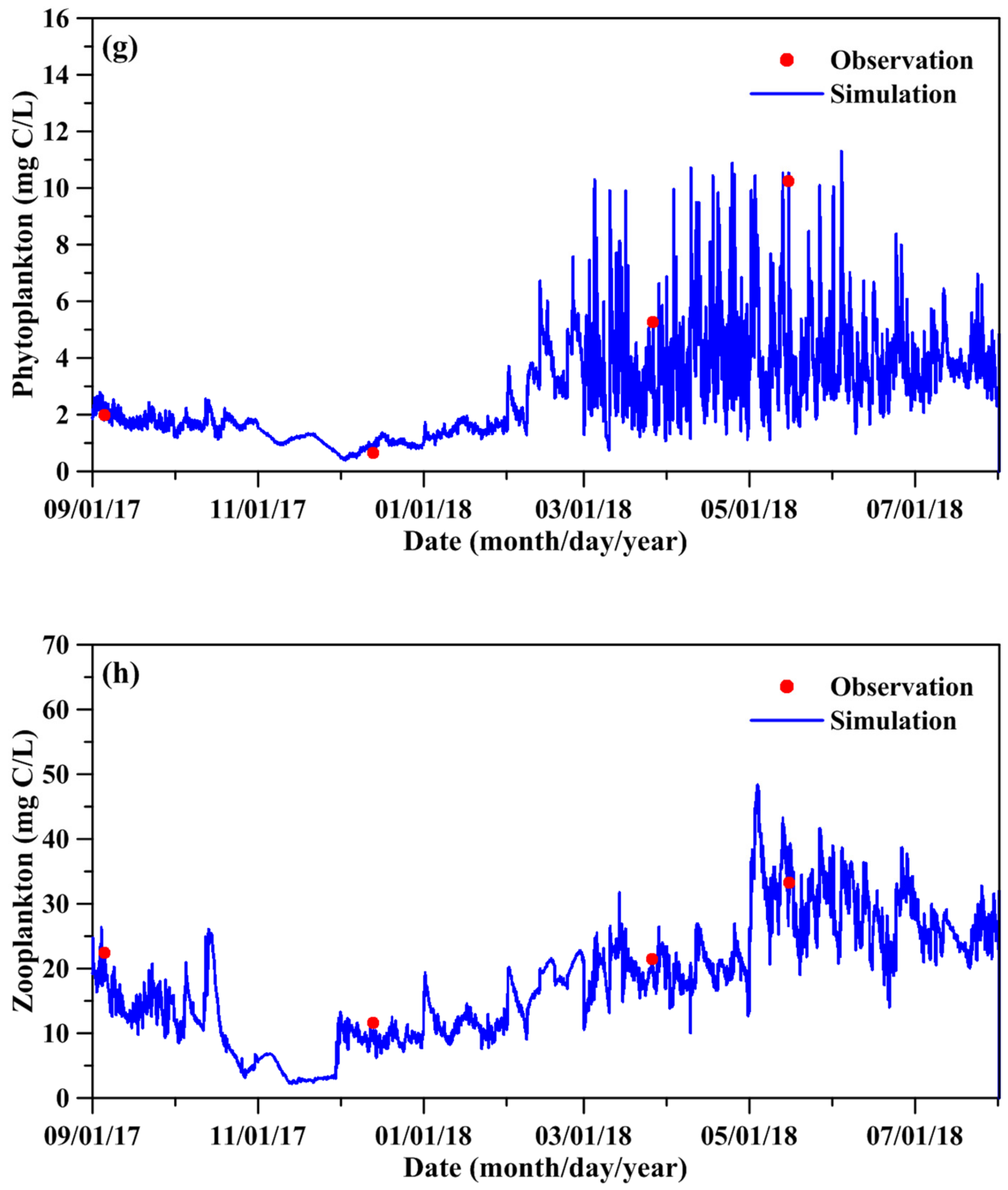


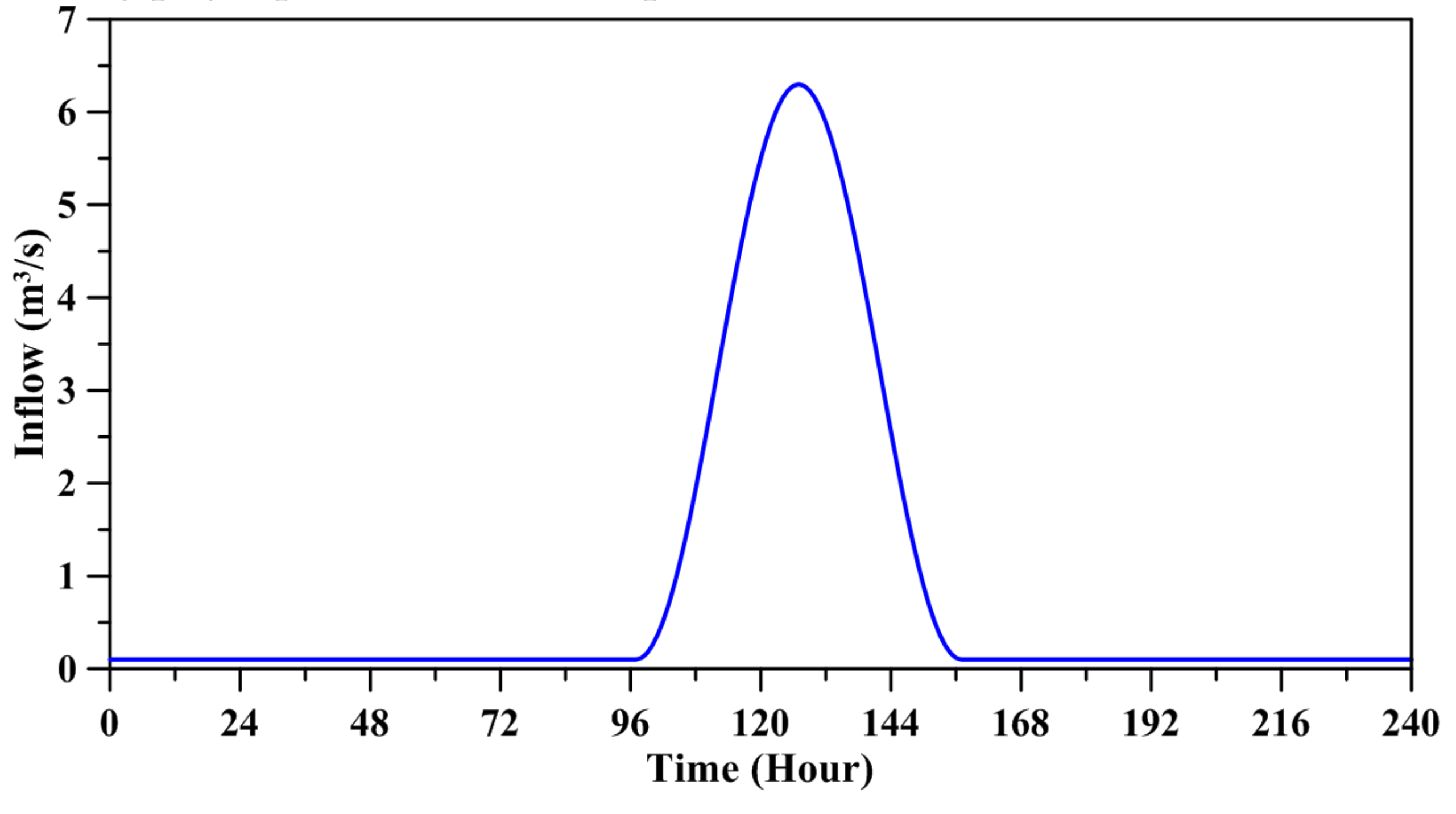


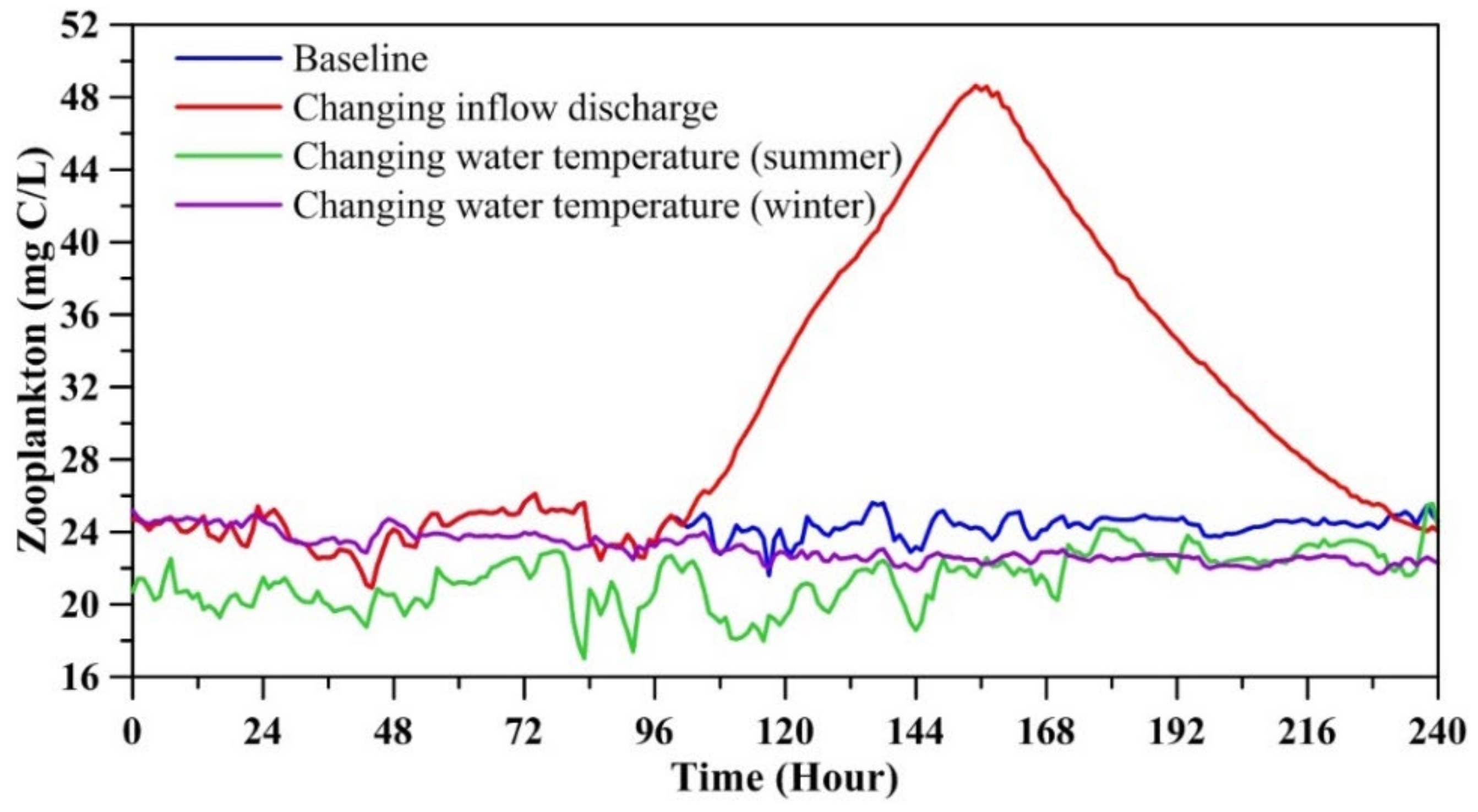


| Year/Month/Date | MAE (°C) | CC | Skill |
|---|---|---|---|
| 2017/09/05 | 0.58 | 0.96 | 0.60 |
| 2017/10/10 | 0.40 | 0.78 | 0.66 |
| 2017/11/21 | 0.18 | 0.91 | 0.56 |
| 2018/01/09 | 0.10 | 0.80 | 0.79 |
| 2018/03/26 | 0.24 | 0.94 | 0.91 |
| 2018/05/15 | 0.86 | 0.68 | 0.66 |
| 2018/06/12 | 0.90 | 0.78 | 0.86 |
| 2018/07/17 | 0.15 | 0.98 | 0.99 |
| State Variable | MAE (Unit in State Variable) | CC | Skill |
|---|---|---|---|
| DO (mg/L) | 0.22 | 0.87 | 0.92 |
| DOC (mg C/L) | 0.08 | 0.98 | 0.95 |
| NH4 (mg/L) | 0.02 | 0.86 | 0.90 |
| DON (mg/L) | 0.03 | 0.93 | 0.96 |
| PO4 (mg/L) | 0.002 | 0.99 | 0.91 |
| DOP (mg/L) | 0.005 | 0.96 | 0.96 |
| Phytoplankton biomass (mg C/L) | 0.16 | 0.99 | 0.95 |
| Zooplankton biomass (mg C/L) | 0.96 | 0.99 | 0.95 |
| Parameter | Condition | Phytoplankton (%) | Zooplankton (%) |
|---|---|---|---|
| Growth rate of phytoplankton (GP) | +50% −50% | 8.67 −21.80 | −0.08 0.51 |
| Basal metabolism rate of phytoplankton (BMP) | +50% −50% | −0.73 0.72 | 0.03 −0.02 |
| Predation rate on phytoplankton (PRP) | +50% −50% | −44.36 157.12 | 1.96 −5.12 |
| Settling velocity of phytoplankton (WS) | +50% −50% | −0.13 0.13 | −0.01 0.01 |
| Growth rate of zooplankton (GZ) | +50% −50% | -28.05 55.03 | 28.43 −28.34 |
| Basal metabolism rate of zooplankton (BMZ) | +50% −50% | 52.10 −41.98 | −28.74 62.54 |
| Mortality rate of zooplankton (PRZ) | +50% −50% | 0.34 −0.34 | −0.26 0.26 |
Publisher’s Note: MDPI stays neutral with regard to jurisdictional claims in published maps and institutional affiliations. |
© 2021 by the authors. Licensee MDPI, Basel, Switzerland. This article is an open access article distributed under the terms and conditions of the Creative Commons Attribution (CC BY) license (https://creativecommons.org/licenses/by/4.0/).
Share and Cite
Liu, W.-C.; Liu, H.-M.; Yam, R.S.-W. A Three-Dimensional Coupled Hydrodynamic-Ecological Modeling to Assess the Planktonic Biomass in a Subalpine Lake. Sustainability 2021, 13, 12377. https://doi.org/10.3390/su132212377
Liu W-C, Liu H-M, Yam RS-W. A Three-Dimensional Coupled Hydrodynamic-Ecological Modeling to Assess the Planktonic Biomass in a Subalpine Lake. Sustainability. 2021; 13(22):12377. https://doi.org/10.3390/su132212377
Chicago/Turabian StyleLiu, Wen-Cheng, Hong-Ming Liu, and Rita Sau-Wai Yam. 2021. "A Three-Dimensional Coupled Hydrodynamic-Ecological Modeling to Assess the Planktonic Biomass in a Subalpine Lake" Sustainability 13, no. 22: 12377. https://doi.org/10.3390/su132212377







